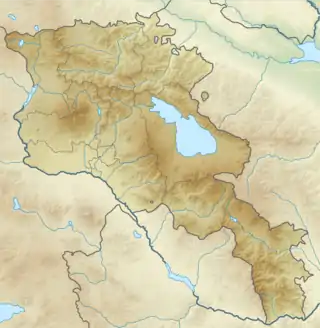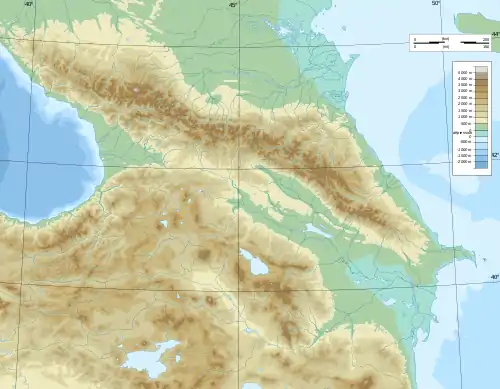| Battle of Artaxata | |||||||
|---|---|---|---|---|---|---|---|
| Part of Third Mithridatic War | |||||||
 View of Khor Virap Monastery. The hill where the monastery was built is the location of now ruined Artaxata | |||||||
| |||||||
| Belligerents | |||||||
| Roman Republic |
Kingdom of Armenia Mithridates VI of Pontus | ||||||
| Commanders and leaders | |||||||
| Lucius Licinius Lucullus |
Tigranes II of Armenia Mithridates VI of Pontus | ||||||
| Strength | |||||||
|
15,000+ infantry 1,500+ cavalry an unknown number of allies | unknown but a significant number of cavalry and infantry | ||||||
| Casualties and losses | |||||||
| unknown | unknown but higher | ||||||
 Location within Armenia  Battle of Artaxata (Caucasus mountains) | |||||||
The Battle of Artaxata was fought near the Arsanias River in 68 BC between an army of the Roman Republic and the army of the Kingdom of Armenia. The Romans were led by proconsul Lucius Licinius Lucullus, while the Armenians were led by Tigranes II of Armenia, who was sheltering Mithridates VI of Pontus. The battle was part of the Third Mithridatic War, and was a Roman victory.
Background
After being defeated by the Romans in Asia Minor and in his native kingdom of Pontus, Mithridates VI of Pontus fled to his son-in-law Tigranes II of Armenia. Lucullus sent his brother-in-law Appius Claudius Pulcher to negotiate the surrender of Mithridates but this effort failed.[3] In 69 BC Lucullus suddenly marched his relatively small army into Armenia catching the Armenian king off guard. Tigranes assembled a large (but untrained) army and the two forces met at Tigranocerta, the kingdom's new capital, with Lucullus decisively winning the ensuing battle.[4] Tigranes and Mithridates fled north to Armenia's old capital of Artaxata, where they recruited, trained and equipped a new army. The next year, Lucullus marched his army north intend on forcing his enemies into a decisive battle.
Prelude
The Romans were marching towards Artaxata, the Kingdom's old capital, to force Tigranes to do battle. Tigranes, on Mithridates' advice, had been avoiding a battle after being defeated at Tigranocerta. He knew his untrained army was no match for the disciplined and battle-hardened Roman troops. Since the Romans' objective (Artaxata) was clear to them, Tigranes and Mithridates had been preparing and training their army for the unavoidable battle but needed time. Lucullus was not inclined to grant them the time needed and marched straight for the capital. Eventually Tigranes had little choice and confronted the Romans. Lucullus made sacrifices to the gods and then marched out of his camp for a pitched battle.
The battle
The Armenian force consisted of a significant cavalry and infantry array protected by mounted archers and Iberian lance-men. There was an initial skirmish between these Iberians and the Roman horse, and soon the Iberians were in full flight. Tigranes then showed up with a huge contingent of cavalry. Lucullus is said to have been frightened by the number of enemies. He halted his cavalry's pursuit of the Iberians and advanced the infantry on the Atropani who were massed opposite it. These were routed, and soon the entire Armenian army was in retreat.[5]
Aftermath
Soon after the battle, there was a near mutiny in Lucullus' camp. His troops were worn out after marching for 960 miles (1,500 km) and fighting many battles with little to show for it. They refused to march after Tigranes and Mithridates and forced Lucullus to turn south and invade the Armenian possessions in Mesopotamia. Mithridates and Tigranes turned to guerrilla warfare and soon, Armenia was back in Tigranes' hands. Mithridates returned to Pontus where he was able to regain power after the Battle of Zela . Eventually, the Roman Senate sent Pompey the great to replace Lucullus and finish off Mithridates. Pompey was successful, and Mithridates was defeated at the Battle of Lycus in 66 BC, while Tigranes submitted a few months later. In 63 BC, the third Mithridatic war finally ended when Mithridates, at the age of 68, committed suicide after his son rebelled at Phanagoria, along the eastern shore of the Cimmerian Bosporus.[6]
References
- ↑ Catherine Steel, The End of the Roman Republic 146 to 44 BC: Conquest and Crisis, (Edinburgh University Press, 2013), 141; Lee Frantantuono, Lucullus, the life and campaigns of a Roman conqueror, p.103.
- ↑ Sherwin-White 1994, p. 242.
- ↑ Lee Frantantuono, Lucullus, the life and campaigns of a Roman conqueror, p.103.
- ↑ Lee Frantantuono, Lucullus, the life and campaigns of a Roman conqueror, pp.89-91; Philip Matyszak, Mithridates the Great, Rome's indomitable enemy, pp.128-136.
- ↑ Plutarch, Vita Luculli XXXI 4-8(Life of Lucullus, 31.4-8); Lee Frantantuono, Lucullus, the life and campaigns of a Roman conqueror, p.103; Philip Matyszak, Mithridates the Great, Rome's indomitable enemy, p.139.
- ↑ Philip Matyszak, Mithridates the Great, Rome's indomitable enemy, pp.159-162.
Sources
- An Encyclopedia of Battles: Accounts of Over 1560 Battles from 1479 B.C. to the Present By David Eggenberger - Page 30
- Plutarch, Vita Luculli XXXI 4-8(Life of Lucullus, 31.4-8).
- Lee Frantantuono, Lucullus, the life and campaigns of a Roman conqueror, p.103.
- Philip Matyszak, Mithridates the Great, Rome's indomitable enemy, p.139.
- Sherwin-White, A. N. (1994). "Lucullus, Pompey and the East 8a - Lucullus, Pompey and the East". In Crook, John; Lintott, Andrew; Rawson, Elizabeth (eds.). The Cambridge Ancient History, Volume 9: The Last Age of the Roman Republic, 146–43 BC. Vol. 9. Cambridge University Press. pp. 229–273. ISBN 978-0521256032.